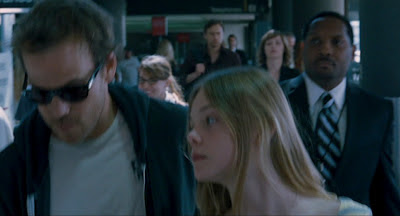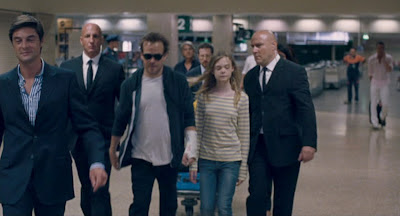Literature
About a year ago, the New Yorker film critic David Denby took me to task for falling into "the classic idiocy of auteurism" concerning Sofia Coppola; I had written a retort to his review of Coppola's film Somewhere. Well I just watched Somewhere for the second time, and I am even more convinced than ever that it is a brilliant film, and far more subtle and sly than Denby gives it credit for.
I take my cue?perhaps not surprisingly?from the way the culture of flight is evoked in the film. At one point, our main character Johnny Marco has to fly to Milan for a publicity junket of sorts. We get two airport scenes: one as Johnny and his daughter Cleo enter LAX, and another as Johnny & Cleo exit Malpensa airport. The flight, on the other hand, is completely elided:
They arrive at LAX,

one second elapses,

and they are in Milan, trudging through the baggage claim.
Perhaps these brief scenes would not stand out so much if they were not placed in the exact middle of the film. As it is, Coppola has set an international air travel spree at the precise center point of this narrative: the artwork balances on this almost instantaneous vehiculation across vast space and considerable time. It is a journey evoked and yet entirely undermined by two brief passages through the gritty endpoints we recognize as cavernous and bland terminal-scapes: one for DEPARTURES, and the other for ARRIVALS. Everything else is left out.
By this move Coppola shows us just what she means by the phrase "postmodern globalism"?a phrase explicitly mentioned at one point in the film, and received with a look of exasperated bewilderment by Johnny.
Postmodern globalism: it might at first sound like an ironic bit of academic jargon dropped into the film to demonstrate just how cut-off from thought Johnny Marco is. But there's actually something to take from this little utterance, and a literary lineage to trace.
Globalism isn't new, of course, and it might not even be 'modern'. For the sake of this inquiry, though, let's track one way that globalism can be seen to shift from the modern to the postmodern. Ernest Hemingway's iconic Modernist novel The Sun Also Rises famously explores the malaise of American expatriates in Paris and Spain in the mid-1920s. The main character of that novel, Jake Barnes, is wounded from an airplane accident: he was a military pilot who flew "on a joke front" of the war. For Hemingway, modern globalism involves humans who are charged to fly planes in the service of conflicts of dubious origins and ends.
Thirty years later, James Baldwin's novel Giovanni's Room chronicles another tale of wandering Americans who are in search of lost identity, again in Paris and Spain. At one point in the novel the character Hella announces that she took a commercial flight in Spain and would never do it again: she claims the plane shook like a Model-T, and it probably was a Model-T at one point before it became an airplane. Baldwin's globalism in this scene marks another stage on the way to the postmodern: the materials of history (here, a Ford automobile) have been transported, updated, and recycled into another means of travel?but these materials are still haunted by latent limitations and deficiencies. The lampooned passenger aircraft in Giovanni's Room functions as an uncertain means of flight?not as existentially dangerous as Hemingway's fighter plane, yet perhaps more disorienting for how it seems to scramble senses of time, space, and belonging (an old car and a newer airplane; Detroit and Spain; being a tourist and being a tourist trying to escape an initial point of tourism).
Now consider again the airports in Somewhere. We could have easily had scenes of Johnny and Cleo in a First Class sleeper cabin on a Boeing 777?such scenes would have fit right into the hotel psychogeography explored by the rest of the film. But by placing the flight in a cinematic lacuna, by only showing us the airport passages, Coppola effectively exposes the postmodern globalism at work in the film: this is a world where high-speed air travel is no longer a matter of consciousness?it's not even experienced. It's completely taken for granted.
If Hemingway was showing us how people repressed early airborne-inflicted trauma, and Baldwin showed us how the increasing banality of flight meshes with increasingly global (non)identity, Coppola shows us a new phase: flight driven down into the unconscious. In the land of Somewhere, air travel is everywhere and nowhere at once. Air travel is the absent presence in the film, and placed as it is at the exact center point of this story, it may very well be the key to the mystery of global postmodernism. A key, however, that the more we turn, the more it seems to throw itself away.
Another New Yorker critic, Richard Brody, praised Somewhere for how "internalized" the film is. As Brody puts it, "at the same time as the shots show a reality accessible to all, they seem wrenched from the psyches of the characters." Brody goes on to describe his experience of the film as "feeling as if I had just been cruising around in a high-powered vehicle for an hour and a half, experiencing a strangely original ride through familiar grounds, a peculiar and delightful blend of the grippingly concrete and the dreamily abstracted." Brody is most obviously alluding to the black Ferrari that Johnny Marco drives around throughout the film; but I wonder if, on another level, Brody's "high-powered vehicle" is also the thundering jetliners that contemporary life has come to internalize so well.

- Ends Of Things
film equipment for The End of the Tour at the Muskegon Airport in Michigan I wrote about the film The End of the Tour for 3:AM Magazine. I can't tell if the current hype around David Foster Wallace?spurred on by the film and countless reviews...
- Airport Reading, Airplane Reading: Definitions & Distinctions
Airport reading, airplane reading. What's the difference? These two phrases often are conflated or used interchangeably. I use these phrases in fairly distinct ways, which I want to delineate briefly here. Airport reading can mean just the trashy...
- It's In The Air
A short essay about my airport work?cleaning out aircraft seat-back pockets at night?is in the current issue of Narrative magazine. Meanwhile, over at Room 220 Nate Martin recently discussed the fantastic atmospheric photographs of JFK by Sophie Lvoff,...
- Up In The Air
Jason Reitman's film adaptation of Walter Kirn's novel UP IN THE AIR treats the subject of flight in two not entirely compatible ways, and these ways can be seen in this promotional still, with the singular George Clooney?s contemplative face...
- Down On Up
The problems with Pixar?s latest film Up are primarily formal ones. These include the onslaught of events, and a virtual saturation of characters. The events in Up are sequenced irregularly and create strange senses of importance: for instance, the breaking...
Literature
The Airports in "Somewhere"
About a year ago, the New Yorker film critic David Denby took me to task for falling into "the classic idiocy of auteurism" concerning Sofia Coppola; I had written a retort to his review of Coppola's film Somewhere. Well I just watched Somewhere for the second time, and I am even more convinced than ever that it is a brilliant film, and far more subtle and sly than Denby gives it credit for.
I take my cue?perhaps not surprisingly?from the way the culture of flight is evoked in the film. At one point, our main character Johnny Marco has to fly to Milan for a publicity junket of sorts. We get two airport scenes: one as Johnny and his daughter Cleo enter LAX, and another as Johnny & Cleo exit Malpensa airport. The flight, on the other hand, is completely elided:
They arrive at LAX,

one second elapses,

and they are in Milan, trudging through the baggage claim.
By this move Coppola shows us just what she means by the phrase "postmodern globalism"?a phrase explicitly mentioned at one point in the film, and received with a look of exasperated bewilderment by Johnny.
Postmodern globalism: it might at first sound like an ironic bit of academic jargon dropped into the film to demonstrate just how cut-off from thought Johnny Marco is. But there's actually something to take from this little utterance, and a literary lineage to trace.
Globalism isn't new, of course, and it might not even be 'modern'. For the sake of this inquiry, though, let's track one way that globalism can be seen to shift from the modern to the postmodern. Ernest Hemingway's iconic Modernist novel The Sun Also Rises famously explores the malaise of American expatriates in Paris and Spain in the mid-1920s. The main character of that novel, Jake Barnes, is wounded from an airplane accident: he was a military pilot who flew "on a joke front" of the war. For Hemingway, modern globalism involves humans who are charged to fly planes in the service of conflicts of dubious origins and ends.
Thirty years later, James Baldwin's novel Giovanni's Room chronicles another tale of wandering Americans who are in search of lost identity, again in Paris and Spain. At one point in the novel the character Hella announces that she took a commercial flight in Spain and would never do it again: she claims the plane shook like a Model-T, and it probably was a Model-T at one point before it became an airplane. Baldwin's globalism in this scene marks another stage on the way to the postmodern: the materials of history (here, a Ford automobile) have been transported, updated, and recycled into another means of travel?but these materials are still haunted by latent limitations and deficiencies. The lampooned passenger aircraft in Giovanni's Room functions as an uncertain means of flight?not as existentially dangerous as Hemingway's fighter plane, yet perhaps more disorienting for how it seems to scramble senses of time, space, and belonging (an old car and a newer airplane; Detroit and Spain; being a tourist and being a tourist trying to escape an initial point of tourism).
Now consider again the airports in Somewhere. We could have easily had scenes of Johnny and Cleo in a First Class sleeper cabin on a Boeing 777?such scenes would have fit right into the hotel psychogeography explored by the rest of the film. But by placing the flight in a cinematic lacuna, by only showing us the airport passages, Coppola effectively exposes the postmodern globalism at work in the film: this is a world where high-speed air travel is no longer a matter of consciousness?it's not even experienced. It's completely taken for granted.
If Hemingway was showing us how people repressed early airborne-inflicted trauma, and Baldwin showed us how the increasing banality of flight meshes with increasingly global (non)identity, Coppola shows us a new phase: flight driven down into the unconscious. In the land of Somewhere, air travel is everywhere and nowhere at once. Air travel is the absent presence in the film, and placed as it is at the exact center point of this story, it may very well be the key to the mystery of global postmodernism. A key, however, that the more we turn, the more it seems to throw itself away.
Another New Yorker critic, Richard Brody, praised Somewhere for how "internalized" the film is. As Brody puts it, "at the same time as the shots show a reality accessible to all, they seem wrenched from the psyches of the characters." Brody goes on to describe his experience of the film as "feeling as if I had just been cruising around in a high-powered vehicle for an hour and a half, experiencing a strangely original ride through familiar grounds, a peculiar and delightful blend of the grippingly concrete and the dreamily abstracted." Brody is most obviously alluding to the black Ferrari that Johnny Marco drives around throughout the film; but I wonder if, on another level, Brody's "high-powered vehicle" is also the thundering jetliners that contemporary life has come to internalize so well.
An ordinary plane sighting, Audubon park, New Orleans, 17 February 2012
- Ends Of Things
film equipment for The End of the Tour at the Muskegon Airport in Michigan I wrote about the film The End of the Tour for 3:AM Magazine. I can't tell if the current hype around David Foster Wallace?spurred on by the film and countless reviews...
- Airport Reading, Airplane Reading: Definitions & Distinctions
Airport reading, airplane reading. What's the difference? These two phrases often are conflated or used interchangeably. I use these phrases in fairly distinct ways, which I want to delineate briefly here. Airport reading can mean just the trashy...
- It's In The Air
A short essay about my airport work?cleaning out aircraft seat-back pockets at night?is in the current issue of Narrative magazine. Meanwhile, over at Room 220 Nate Martin recently discussed the fantastic atmospheric photographs of JFK by Sophie Lvoff,...
- Up In The Air
Jason Reitman's film adaptation of Walter Kirn's novel UP IN THE AIR treats the subject of flight in two not entirely compatible ways, and these ways can be seen in this promotional still, with the singular George Clooney?s contemplative face...
- Down On Up
The problems with Pixar?s latest film Up are primarily formal ones. These include the onslaught of events, and a virtual saturation of characters. The events in Up are sequenced irregularly and create strange senses of importance: for instance, the breaking...
